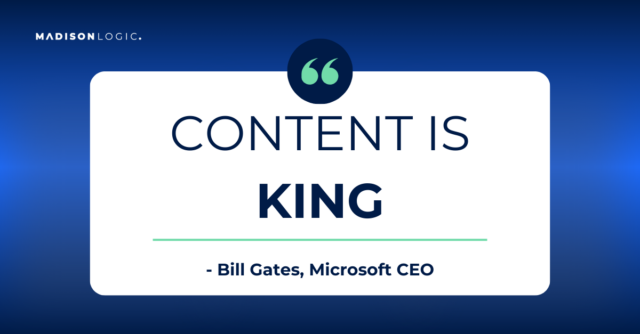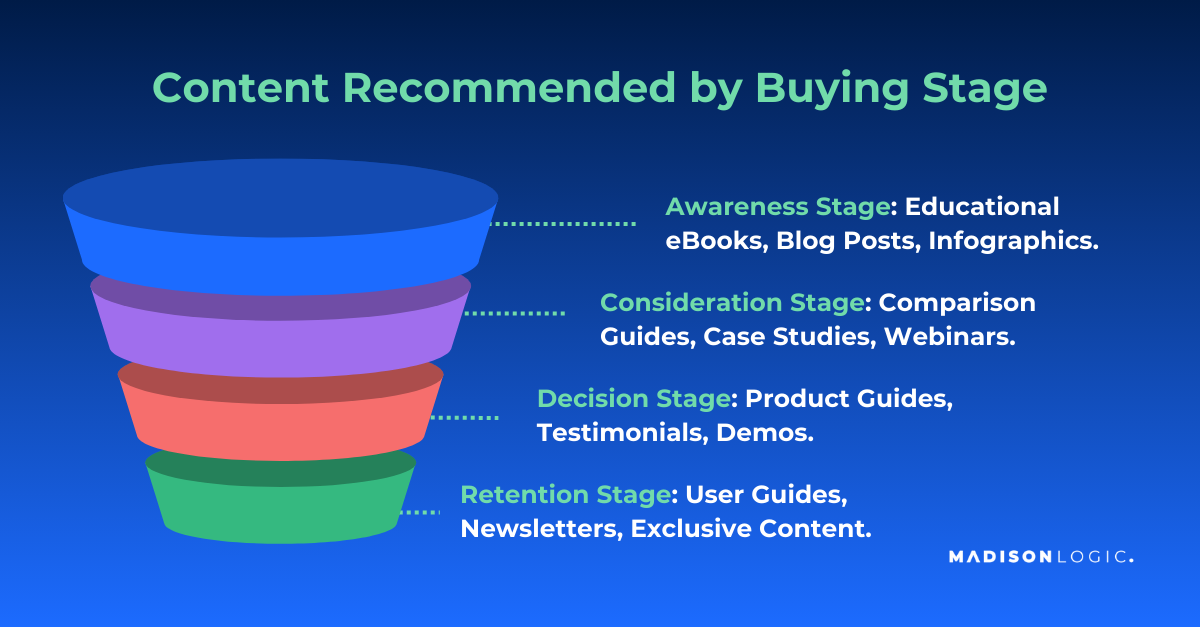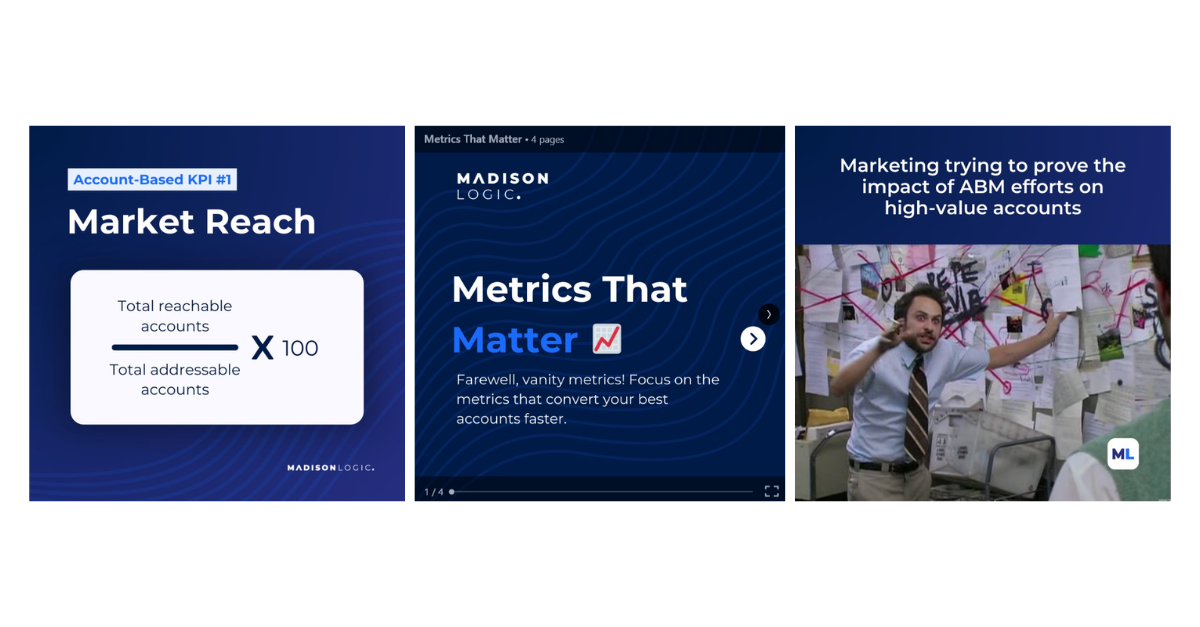
New! Expand your reach and drive real demand with ABM Audio Advertising. Learn More

The goal of content marketing? Creating resources your audience doesn’t just consume—they also save it, share it, and come back for more.
That’s where you can really leverage the power of eBooks in your content marketing strategies. eBooks offer an opportunity to dive deep, educate, and establish credibility and expertise in your industry, positioning your brand as a trusted authority. Despite the growing popularity of other B2B content formats like video, social media posts, and podcasts, Netline’s 2024 Content Consumption Report reveals that eBooks are still the most popular type of B2B content, with a 34.5% increase in registrations year over year.
And as you’ll discover in this article, eBooks go beyond simply educating and inspiring buyers. When strategically integrated into your content marketing strategy, they provide unique advantages in demand generation and lead nurturing, making them an essential asset for any successful B2B marketing campaign.

Whether you’re aiming to educate, inform, or inspire B2B buyers, the type of eBook plays an important role in how it resonates with your audience. From in-depth guides to industry trend reports, each type of eBook serves a unique purpose—and choosing the right one can make all the difference in driving engagement and conversions.
Let’s explore the different types of eBooks that can elevate your content strategy and help you achieve your B2B marketing goals.
Data is the backbone of informed decisions. Industry trend reports cite market data and research, as well as proprietary research, to provide your audience with data-driven insights that help them understand evolving trends, shifts, and future projections within certain industries.
Check out an example industry trend report eBook below. 
When it comes to industry knowledge, there’s no substitute for real, trusted expertise. A thought leadership guide taps into the minds of credible industry experts, offering your audience new perspectives that are both actionable and inspiring.
Choosing a solution is a big commitment—financially, strategically, and operationally. When making any buying decision, a little clarity goes a long way. A product comparison guide breaks down features, benefits, and drawbacks of competing products, making it easier for your audience to make informed decisions.
When it comes to purchasing complex products or services, basic information just doesn’t cut it. A technical deep dive offers an in-depth exploration of your solution’s technical aspects, specifications, and advanced features, helping your buyers truly understand what pain points your solution solves.
Nothing speaks louder than success stories. A case study compilation pulls together real-world examples of how your product or service has made a tangible impact, offering your audience proof of your value. For example, if your company has helped clients boost their marketing ROI through targeted campaigns or enhanced lead generation, this compilation highlights those successes, showcasing your solution in action.
eBooks serve as powerful tools that can elevate your content marketing plan and drive real business results. Let’s dive into five key benefits of using eBooks in your content marketing strategy.
Think of eBooks as a tool to help build your reputation as the go-to expert in your industry. By offering researched and insightful information, a well written eBook positions your brand as an industry thought leader and helps build trust with potential buyers who are looking for expertise before making decisions.
eBooks can enhance credibility through:
Compared to the broad range of marketing materials a company produces, creating an eBook doesn’t require a massive budget.
With the right tools and expertise, eBooks can be produced quickly and cost-effectively, making them an excellent option for B2B businesses of all sizes. Unlike print materials, eBooks are entirely digital, eliminating costs for printing, shipping, and storage. Additionally, they have a long shelf life and can be updated easily, ensuring that your investment pays off over time.
To start writing your eBook you’ll only need a few basics.
One of the biggest content marketing challenges is ensuring your content reaches the right audience. eBooks, however, offer you a variety of distribution options to get your message into the hands of the right people.
The most common approach is offering eBooks as a downloadable resource on your website. By gating the download behind a form, you can collect valuable information such as names, email addresses, and other contact details. This not only delivers the content securely to the right person and help prevent spam bots from inflating your download numbers, but it also helps grow your database of potential qualified leads.
Other distribution methods can help broaden your reach even further, like:
An appealing aspect of eBooks is that people download them because they genuinely want the information, strategies, and insights they offer. This makes eBooks unique: they attract an audience that is actively seeking value, and create an organic opportunity for subtle delivery of marketing messaging around your product. As readers consume your content, they’re not only learning but also forming a connection with your brand, working to build long-lasting relationships that eventually result in conversion.
For example, subtle delivery within your eBook might look like:
Since those who download an eBook are actively seeking information, the leads generated are more likely to be qualified and engaged. This makes these leads more valuable compared to individuals who may only interact with short-form content like blog posts or social media updates.
Additionally, eBooks are ideal for nurture programs and guiding prospects along the buyer’s journey. Whether they’re in the awareness buying stage or close to making a decision, an eBook can provide the education or detailed comparison they need to take the next step.

While eBooks are an effective tool in any content marketing strategy, they come with their challenges. Here are some common hurdles marketers may face when leveraging eBooks in their content marketing strategies, along with tactics to overcome them.
Without a clear understanding of who you’re trying to target, even the most valuable content can fall flat. One of the most significant ABM challenges with eBooks is ensuring they reach the right audience. If your eBook distribution doesn’t align with the needs, interests, or pain points of your ideal audience, its impact will be severely limited.
This can be avoided by taking a strategic approach to audience identification. Make sure you have the following clearly defined before approaching your eBook distribution:
Buyer behavior is constantly evolving, and staying ahead of these changes is critical to the success of your eBook strategy. One key challenge marketers face is deciding whether or not to gate their eBooks with a download form. As buyers become more selective about the personal information they share, understanding when and why to ask for contact details becomes essential to B2B engagement. Consider offering ungated content to awareness stage prospects to build trust, while gating eBooks at later stages when buyers are closer to making decisions and are more likely to share their details.
Additionally, tracking buyer engagement with eBook content can be difficult. While you can see if an eBook is downloaded or opened (if sent via email), deeper insights, like how buyers engage with eBook content, are harder to track. To address this, use marketing automation platforms or analytics tools that allow for more specific tracking of content interactions, such as time spent on pages, specific sections viewed, or engagement with embedded CTAs. This will give you better visibility into how prospects are engaging with your eBook, helping you optimize and refine your content marketing strategy.
The saying “Content is king” rings true today, but with so much content out there, not all of it stands out and resonates with buyers. With countless B2B companies creating similar eBooks, the key to differentiation lies in two key areas: high-quality content creation and effective distribution.
In the age of AI generated content and overwhelming content saturation, truly great content must go beyond basic information. It needs to provide actionable insights, fresh perspectives, or valuable data. Audiences are quick to mistrust content that lacks depth or credibility, so building trust through high-quality writing, design, and research is essential. To truly build trust with your audience, focus on creating high-quality, value-driven content, which offers unique insights, original research, or in-depth expertise that can’t be easily found elsewhere.
Without a strategic distribution plan, even the most valuable content can get lost in the noise. To make an impact, you need to deliver your eBook through the right marketing mix channel strategy so that they arrive at the right time and to the right people.
By leveraging your own first-party data, as well as intent data, you can gain deeper insights into your audience’s preferences and behaviors, allowing you to tailor your messaging to meet their specific needs. Additionally, employing a mix of organic and paid distribution channels—like email marketing, social media, and content syndication—can significantly boost your eBook’s visibility and ensure it reaches the right eyes.
87% of customers won’t do business with a company if concerned about its security practices. As you collect contact information through eBook downloads and other content offers, it’s crucial that you’re handling this data responsibly. Privacy regulations require businesses to be transparent about how they collect, store, and use customer data. To stay compliant, it’s essential to review and ensure adherence to the following key regulations:
Content syndication adds another layer of data privacy complexity. When sharing your eBooks through third-party platforms, it’s vital to confirm that these platforms adhere to the same data privacy standards as well as lead validation transparency. Content syndication providers must employ a multi-stage lead validation process to guarantee that leads are accurate, relevant, and compliant with regulatory requirements and campaign goals. Standards include both automated and human verification stages, with clear documentation of validation benchmarks.
When considering the long sales cycle in B2B marketing (the average B2B deal cycle lasts 6 months), measuring the return on investment (ROI) of your eBook strategy can be challenging. eBooks often serve as part of a broader lead-nurturing process, where the impact becomes apparent over time and the dollar value becomes harder to attribute directly.
To accurately measure ROI, it’s important to track key metrics and KPIs throughout the entire funnel, from initial engagement to final conversion. We recommend focusing on the following ABM measurement metrics:
Account engagement measures interactions such as website visits, email opens, and content downloads from target accounts. This KPI indicates the level of interest and engagement from your targeted accounts, helping to assess the effectiveness of your outreach and ABM content strategies.

Audience exposure time tracks the time target accounts spend interacting with your content. This metric reflects the quality and relevance of your content to the audience.

Pipeline velocity measures the speed at which opportunities move through the sales pipeline, focusing on the time taken from opportunity creation to closing the deal. This helps evaluate the efficiency of your sales process and identify potential bottlenecks. Measuring the speed at which a lead moves down the sales pipeline tells you a lot about how buyers engage with your content and messaging.

By tracking these metrics, you can gain valuable insights into what content resonates most with your audience. Use these findings to refine your strategy with the following campaign optimization tactics:
When it comes to ABM, eBooks can be a powerful asset to engage high-value accounts. But to truly maximize their impact, it’s essential to incorporate strategies that drive targeted results. Here are a few smart ways to leverage eBooks for the benefits of ABM campaigns and to accelerate your success.
Much of your eBook’s value comes from thinking beyond the asset itself and finding ways to extend its impact across multi-channel ABM, ensuring you get the most out of your content. By strategically repurposing your eBook content, you can ensure it resonates with your high-value target accounts across various ABM touchpoints. Consider repurposing content into the following formats:
Madison Logic’s Metrics That Matter eBook is an example of this strategy in action. While the eBook itself was a valuable resource, the team repurposed its content into a multi-part LinkedIn social series. This organic campaign received over 10k impressions, boosted website traffic, and increased eBook downloads in the months following its release. Beyond just numbers, it also nurtured prospects, engaged existing customers, and sparked meaningful discussions on social media, amplifying the eBook’s overall reach and effectiveness.

Partnering with industry influencers or internal thought leaders can significantly expand the reach of your eBook, especially when targeting high-value accounts in your ABM strategy. Influencers and recognized figures within your company can share insights, quotes, or data from the eBook on social media, driving its credibility by giving their endorsement alongside driving awarness to your brand.

You can also take B2B influencer marketing a step farther by co-hosting discussions, podcasts, guest blogs, or guest posts centered around the eBook’s content. This collaboration not only boosts your eBook’s exposure but also fosters trust among key accounts.
A survey from Madison Logic and the Harris Poll revealed that 53% of B2B marketers are planning to invest more in video marketing in 2025, while 50% are looking to increase their investment in podcasting. Leveraging your eBook’s content is the perfect use case for creating a webinar or podcast episode. By transforming key insights from your eBook into a more interactive and engaging format, you can deepen your connection with your target accounts, provide additional value, and extend the reach of your content.
Marketers who employ content syndication for B2B are far more likely to achieve their goals. In fact, 80% of B2B marketers who use content syndication report the channel as their most effective lead generation tactic. ABM content syndication can help deliver your high–value eBook directly to key decision-makers, creating deeper buyer engagement, accelerating alignment, and priming your sales team with qualified, engaged audiences.
By distributing your valuable content on third-party platforms, you can reach a larger audience, establish credibility, and attract target accounts who are actively seeking information about your solution. This targeted content distribution strategy ensures that your eBook reaches the right audience, including those unfamiliar with your organization and the value of its solutions. By promoting your eBook across various platforms, you will broaden your audience reach, attract quality leads, drive more website traffic, and reinforce your brand recognition.
Once you have a new eBook, packed with actionable insights and strategies, the next step is to get it in front of the people who matter most. Watch this short clip on how ABM Content Syndication is a powerful tool to generate leads, increase brand awareness, and drive accounts into your sales pipeline faster.
Madison Logic empowers B2B marketers to get the most out of not only their ABM Content Syndication, but also their entire account-based marketing strategy. With ML Measurement, marketers can easily analyze multi-channel campaigns to gauge effectiveness, while ML Insights provides valuable data and insights to refine targeted campaigns and improve lead scoring. This all-in-one approach ensures that marketing efforts are aligned, measurable, and drive the right results.
Additionally, transparency in content syndication is critical for ensuring data integrity and building trust in your marketing efforts. Madison Logic is at the forefront of setting new standards for transparency and accountability in content syndication, to learn how, download our whitepaper: Leading the Charge in Transparency. Ready to work with a trusted partner for your content syndication efforts? Request a demo today to learn how the ML Platform puts your best content in the hands of in-market accounts researching solutions like yours.